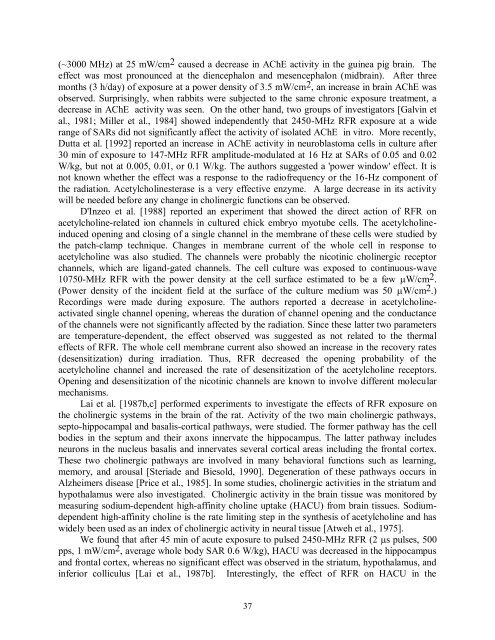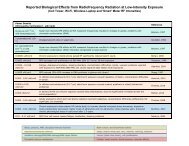Evidence for Effects on Neurology and Behavior - BioInitiative Report
Evidence for Effects on Neurology and Behavior - BioInitiative Report
Evidence for Effects on Neurology and Behavior - BioInitiative Report
Create successful ePaper yourself
Turn your PDF publications into a flip-book with our unique Google optimized e-Paper software.
(~3000 MHz) at 25 mW/cm 2 caused a decrease in AChE activity in the guinea pig brain. The<br />
effect was most pr<strong>on</strong>ounced at the diencephal<strong>on</strong> <strong>and</strong> mesencephal<strong>on</strong> (midbrain). After three<br />
m<strong>on</strong>ths (3 h/day) of exposure at a power density of 3.5 mW/cm 2 , an increase in brain AChE was<br />
observed. Surprisingly, when rabbits were subjected to the same chr<strong>on</strong>ic exposure treatment, a<br />
decrease in AChE activity was seen. On the other h<strong>and</strong>, two groups of investigators [Galvin et<br />
al., 1981; Miller et al., 1984] showed independently that 2450-MHz RFR exposure at a wide<br />
range of SARs did not significantly affect the activity of isolated AChE in vitro. More recently,<br />
Dutta et al. [1992] reported an increase in AChE activity in neuroblastoma cells in culture after<br />
30 min of exposure to 147-MHz RFR amplitude-modulated at 16 Hz at SARs of 0.05 <strong>and</strong> 0.02<br />
W/kg, but not at 0.005, 0.01, or 0.1 W/kg. The authors suggested a 'power window' effect. It is<br />
not known whether the effect was a resp<strong>on</strong>se to the radiofrequency or the 16-Hz comp<strong>on</strong>ent of<br />
the radiati<strong>on</strong>. Acetylcholinesterase is a very effective enzyme. A large decrease in its activity<br />
will be needed be<str<strong>on</strong>g>for</str<strong>on</strong>g>e any change in cholinergic functi<strong>on</strong>s can be observed.<br />
D'Inzeo et al. [1988] reported an experiment that showed the direct acti<strong>on</strong> of RFR <strong>on</strong><br />
acetylcholine-related i<strong>on</strong> channels in cultured chick embryo myotube cells. The acetylcholineinduced<br />
opening <strong>and</strong> closing of a single channel in the membrane of these cells were studied by<br />
the patch-clamp technique. Changes in membrane current of the whole cell in resp<strong>on</strong>se to<br />
acetylcholine was also studied. The channels were probably the nicotinic cholinergic receptor<br />
channels, which are lig<strong>and</strong>-gated channels. The cell culture was exposed to c<strong>on</strong>tinuous-wave<br />
10750-MHz RFR with the power density at the cell surface estimated to be a few W/cm 2 .<br />
(Power density of the incident field at the surface of the culture medium was 50 W/cm 2 .)<br />
Recordings were made during exposure. The authors reported a decrease in acetylcholineactivated<br />
single channel opening, whereas the durati<strong>on</strong> of channel opening <strong>and</strong> the c<strong>on</strong>ductance<br />
of the channels were not significantly affected by the radiati<strong>on</strong>. Since these latter two parameters<br />
are temperature-dependent, the effect observed was suggested as not related to the thermal<br />
effects of RFR. The whole cell membrane current also showed an increase in the recovery rates<br />
(desensitizati<strong>on</strong>) during irradiati<strong>on</strong>. Thus, RFR decreased the opening probability of the<br />
acetylcholine channel <strong>and</strong> increased the rate of desensitizati<strong>on</strong> of the acetylcholine receptors.<br />
Opening <strong>and</strong> desensitizati<strong>on</strong> of the nicotinic channels are known to involve different molecular<br />
mechanisms.<br />
Lai et al. [1987b,c] per<str<strong>on</strong>g>for</str<strong>on</strong>g>med experiments to investigate the effects of RFR exposure <strong>on</strong><br />
the cholinergic systems in the brain of the rat. Activity of the two main cholinergic pathways,<br />
septo-hippocampal <strong>and</strong> basalis-cortical pathways, were studied. The <str<strong>on</strong>g>for</str<strong>on</strong>g>mer pathway has the cell<br />
bodies in the septum <strong>and</strong> their ax<strong>on</strong>s innervate the hippocampus. The latter pathway includes<br />
neur<strong>on</strong>s in the nucleus basalis <strong>and</strong> innervates several cortical areas including the fr<strong>on</strong>tal cortex.<br />
These two cholinergic pathways are involved in many behavioral functi<strong>on</strong>s such as learning,<br />
memory, <strong>and</strong> arousal [Steriade <strong>and</strong> Biesold, 1990]. Degenerati<strong>on</strong> of these pathways occurs in<br />
Alzheimers disease [Price et al., 1985]. In some studies, cholinergic activities in the striatum <strong>and</strong><br />
hypothalamus were also investigated. Cholinergic activity in the brain tissue was m<strong>on</strong>itored by<br />
measuring sodium-dependent high-affinity choline uptake (HACU) from brain tissues. Sodiumdependent<br />
high-affinity choline is the rate limiting step in the synthesis of acetylcholine <strong>and</strong> has<br />
widely been used as an index of cholinergic activity in neural tissue [Atweh et al., 1975].<br />
We found that after 45 min of acute exposure to pulsed 2450-MHz RFR (2 s pulses, 500<br />
pps, 1 mW/cm 2 , average whole body SAR 0.6 W/kg), HACU was decreased in the hippocampus<br />
<strong>and</strong> fr<strong>on</strong>tal cortex, whereas no significant effect was observed in the striatum, hypothalamus, <strong>and</strong><br />
inferior colliculus [Lai et al., 1987b]. Interestingly, the effect of RFR <strong>on</strong> HACU in the<br />
37



